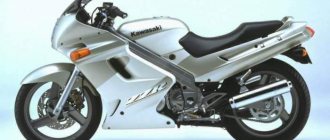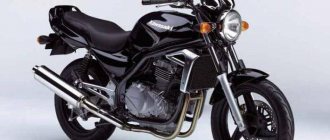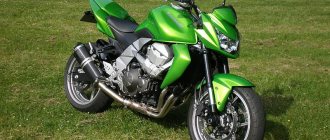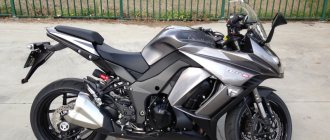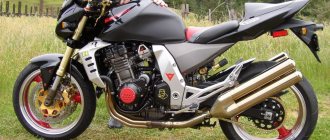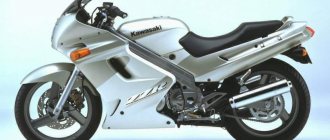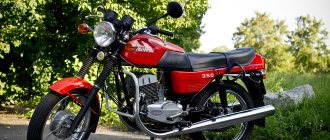- motorcycle model, Kawasaki brand,
The Kawasaki Xanthus 400 naked model appeared in 1992 and was produced until 1995. It is worth noting that this was the first factory streetfighter from Kawasaki, built on the basis of the Kawasaki ZXR 400 sports model. It is distinguished by minimal plastic, an aluminum diagonal frame, a square headlight and a slightly retuned engine (to increase traction at low and medium speeds). Unlike the ZXR 400, the Xanthus had a conventional telescopic fork.
The main feature of the Kawasaki Xanthus 400 is its liquid-cooled inline 4-cylinder engine, which produces a standard 53 hp. power and 36 Nm of torque. It differs from the ZXR 400 engine only in camshafts and visually; it also has an oil cooler. Like all sports in-line 400s, this engine is high-speed and produces maximum performance at 9000-11000 rpm.
Despite its interesting appearance and technical solutions that were ahead of its time, the Kawasaki Xanthus 400 was produced for only 3 years, after which it was replaced by the “classic” - the Kawasaki ZRX 400.
Advantages
Nevertheless, the motorcycle left a noticeable mark on history, and many similar machines now use the developments introduced in it. The bike certainly had the following advantages:
- interesting design;
- the engine was quite powerful for those times;
- maneuverability.
The motorcycle was an excellent choice for those who did not plan to use the bike for long distances. Many considered it a good solution for urban agglomerations. The maneuverability of the motorcycle is truly impressive, both at medium and high speeds.
Kawasaki turned out to be a very decent bike that could easily compete with many modern analogues. The technological solutions laid down then would have made it competitive at least until 2010.
Review of the Kawasaki Xanthus 400 (ZR400D) motorcycle
As for the device itself, its design was ahead of its time; at that time the NEOCLASSIC niche did not exist at all; let’s say, it was a pioneer. So much has been written about design, good and bad, but design really exists. And not everyone likes it, fact. But this is the highlight of the device. He makes you look around. There's no arguing with that. The frame was also a highlight for that time. In terms of application on the device, it is more similar to the classic one. Also the original design of the tidy, which is truly DEFICIT in the secondary market! As you know, when you fall, it is this part that suffers very much. And it is made in a fused body, at the same time performing the function of a windbreaker. What is undoubtedly a plus is comfort at cruising speeds of around 140 km/h. The headwind is not so overwhelming. I rode this device and... well, I put it in short. It was a long time ago. Just in 2003.
As for the driving characteristics. Yes, indeed, it was fashionable to install engines on classics, from their sports counterparts, so we know that the Super Fur has a motor from SiBiRa, On the Impulse, in my opinion, from the little Jixer. I think it’s the same story with little Phaser. Perhaps I made a mistake somewhere. If there is anything, please correct it. Cactus did not escape fashionable consideration either, having received a motor from Zakhar, and along with it his sores. It’s not that it’s completely bad (I’m talking about the engine), but difficult-to-maintain carburetors and an incomprehensible gearbox with a second gear that is always not plugged in and out of gear have migrated in full (so to speak) in full. Overall the device is very reliable. It couldn’t be otherwise! In fierce competition, not a single manufacturer could afford to produce a product of lower quality than its competitors (by the way, this is written in the magazine, and one cannot disagree with this).
But in general, the device has a direct landing and a straight steering wheel. It steers... well, how else can a 400, with an aluminum diagonal frame and a short wheelbase, steer? Fine. Although the mot is peculiar. He was way ahead of his time. And it didn't sell very well in Japan. And it was made for the domestic market. Try it, then try it, but it’s difficult to find a good device in Japan. There are simply few of them. And what we have is not trash, of course, but it’s not first or even third freshness either. It will soon become like a Honda Magna. A legend desired by many. But so rare. I would oppose Hornet to him, but...
For its time, the motorcycle was simply revolutionary. The characteristics of the motorcycle are impressive: the engine is from the super sporty ZX4R Ninja, with a power of 53 hp (without afterburner), the brakes are from the ZX9R, the frame is of the spinal monocurrent type (the ZXR has a duplex frame), almost no plastic, dry weight is only 168 kg, with all this a classic fit and a completely flexible disposition. This motorcycle can be said to have opened the Naked or Streetfighter category at one time. The motorcycle is definitely evil both in terms of characteristics and ride quality. In terms of maximum speed, perhaps only the Yamaha FZR400 and Honda VFR400 can compare with it, and even then it all depends on the pilots - all the other motorcycles (in this class) are just nervously smoking in the corner. But Kawasaki is very different from its closest competitors, it is not a pure track Honda with its monstrous uncomfortable landing, or an inadequate Yamaha with its completely unpredictable acceleration curve. YES it is not as sharp as its competitors, one person even managed to say that this is a women’s motorcycle, but is it necessary to be so sharp? in traffic jams it behaves completely adequately and predictably - you need to fry the gas - it will fry, you need to stand in stoppies or sharply change lanes - for God's sake, as much as you like, you want a wheelie or a knee turn - spit it out, with no yaw jerks or wobbles. In general, here it is a masterpiece of that time...
I fell in love with the Xanthus at first sight, taut, with a diagonal aluminum frame, a huge square headlight with two reflectors, a fighter's raised tail and a dual muffler on the right, it became for me the personification of an angry city motorcycle. This geometry, combined with large brake discs, a low steering angle and a monoshock, should have made its handling sharp and predictable. The engine was borrowed from the ZXR400, which was supplied to Europe, so there should not have been any special difficulties in finding spare parts for the engine. The engine was derated to 53 hp, the crankcase was replaced with a larger capacity, but the oil cooler was removed, and the radiator was significantly reduced. The engine runs quite noisily, with a slight clicking sound, but you won’t be able to hear the fault. I also appreciated the lack of plastic as a plus for a beginner.
So, the purchase took place. I got a car manufactured in 1996, which had been in Moscow for one year and had 15,000 km on the odometer (they’re lying, of course). I won’t describe how I learned to ride, I’ll just leave my impressions of the motorcycle (at the time of writing this article, I had ridden about 7 thousand km on the Xanthus, 4 thousand on the ZZR 600, and a little on some other Japanese ones).
The riding position on the motorcycle is classic; for me, with a height of 180 and a weight of 95 kg, it was quite comfortable (I note that on my motorcycle, instead of a standard handlebar, there were halves and clip-ons, so the landing was somewhat more sporty). The hips fit comfortably into the recesses on the tank. The rear seat is small, but allows you to carry passengers, but the seating position for them cannot be called comfortable; the footrests are a bit high. The motorcycle is equipped with a healthy square headlight with two round reflectors inside; both lamps burn at the same time and do not produce a weak light beam (compared to its “one-eyed” counterparts). The instrument panel is equipped with a tachometer, speedometer, neutral indicator, fuel level, engine temperature, oil pressure, turn signal and high beam indicators. In general, the readings are easy to read even in bright daylight.
In order to increase the stiffness of the suspension, the rear monoshock absorber was tightened almost all the way, one notch remained, and fork oil with a viscosity index of 15 was poured into the fork.
The motorcycle pleases with its controllability, shows absolutely no tendency to bend the fork (see zizer, bandit), the rigid frame and pendulum allow you to lower the motorcycle to the pegs and take turns at a good speed, while the motorcycle does not wag its tail like a happy dog. I consider 140 km/h to be a comfortable speed for a motorcycle; up to 160 the motorcycle picks up quite quickly for a 400, but the remaining 20 doesn’t pick up very readily, and you have to bend down and get blown away. Frequent trips to the karting track in Mytishchi strengthened my confidence - the motorcycle has one of the best suspensions and geometry in the class, holds the road perfectly and allows you to confidently take numerous turns.
The engine runs quite smoothly, good traction starts around 6 thousand rpm, and increases almost without changes (slight pick-up around 11 thousand) to the red zone.
The brakes of the Kawasaki Xanthus are quite adequate to its weight and dynamic characteristics. With skill, you can easily put the motorcycle in stops (this is easier on a bandit), but if possible, I would change the original two-piston calipers to four-piston ones without hesitation. Ideally, I would like to replace the traverses with the fork; in my opinion, they are not rigid enough, but in the neoclassical class they are definitely enough (by the way, the fork on the Xanthus is the same as on the CB400SF).
The disadvantages include a relatively weak timing mechanism (the chain, rollers and tensioner must be replaced after 30-40 thousand km, i.e. they almost always come to Russia with an exhausted timing life) and a heavy exhaust system that is susceptible to corrosion.
As a result, I have very favorable memories from Xanthus, exemplary handling, light weight and responsive engine. A very balanced device for the city and small forays, which was in many ways ahead of its time. The motorcycle is quite reliable, like most Japanese ones, during its operation there was not a single breakdown.
Engine
This car has a four-stroke, four-cylinder engine. It is in-line by type. Its working volume is 398 cubic centimeters. Cooling is liquid. At 9,500 rpm, peak torque is 36 Newton-meters. At 11,500 rpm, peak power is 53 horsepower.
Thanks to this engine, the motorcycle can accelerate to 100 kilometers per hour in less than 5 seconds. At that time it was very good! The maximum speed of the bike was quite high - 180 kilometers per hour.
Specifications
The heart of the bike was the engine, which had already proven itself on a racing motorcycle of its own production, the ZXR400.
Engine – left view.
Engine – right side view.
Cylinder block.
Exhaust manifold.
As is customary on 400s, the engine’s power was reduced to 53 horsepower, due to which they were able to increase torque at low and mid-range speeds, which overall led to good dynamics for the newcomer.
Other parameters include:
- working volume - 398 cm3;
- number of cylinders - 4;
- number of cycles - 4;
- number of valves - 16 (4 per cylinder);
- power - 53 hp;
- torque - 36 Nm;
- cooling - liquid;
- fuel supply - Keihin carburetor, 4x (CVKD30);
- ignition - transistor (TDI);
- start - electric starter;
- tank volume - 14 l.
Users noted that the choice of prototype for the motor was not the best. He had his childhood problems - they moved on to the new bike. At the same time, it was noted that the parent was exported, so finding parts for repairs would not be a problem.
Transmission and clutch
Gear shift foot.
Chain drive.
a 6-speed gearbox is installed on a bike with a claim to racing participation . Installed here, coupled with the ZXR400 , it worked well and shifted smoothly. But from such a tandem the motorcycle received one small problem - second gear. As users note, she doesn’t like her motorcycle and, if possible, tries to get rid of her. Either go to neutral, or demand a higher one.
- Multi-disc clutch, oil bath . Power transmission is a cable .
- The main drive is a chain .
Brakes
Front brakes.
Rear brake.
Rear brake drive.
To describe the brakes in one word - ZX-9R (the brand's racing model, released around the same years). On a 5-point scale, they cope with their role perfectly.
Front:
- number of disks - 2;
- disc diameter - 310 mm;
- support - 2-piston.
Rear:
- number of disks - 1;
- disc diameter - 250 mm;
- support - 1-piston.
Options were not yet developed at the time of production.
Dimensions and weight
The length of the motorcycle is average - 2030 millimeters. Its height is 1070 millimeters. Width – 745 millimeters. The saddle height reaches 775 millimeters. The curb weight of the bike is 186 kilograms, and the gas tank capacity is 14 liters. The wheelbase size is 1380 millimeters.
Modifications and competitors
The bike did not have time to acquire any standard factory modifications.
As the developers said, having released such an unsuccessful version and being afraid to fly out of the 2-wheeled motorcycle market, the model was closed and tried to be forgotten.
CB400F
Honda CB400F - steel frame, simple suspension and one brake disc for each wheel.
But the fears turned out to be unjustified. This is confirmed by the presence of competitors to the model. Official publications name only one version. This is the CB-1, sometimes referred to as the CB400F. Brand Honda.
Others
Besides her, users name several more.
- CB400 is the same Honda, a classic naked bike.
- FZR 400 - sport. Manufactured by Yamaxa (Probably due to comparable maximum speed and dynamics).
- The VFR400 is also a sport. Brand Honda.
This also includes several variations of the Suzuki, for example the bandit version with 400 cc.
Chassis and brakes
The motorcycle frame is diagonal, made of aluminum. It perfectly reflects the character and type of motorcycle. The characteristic outlines are easy to recognize even in a motorcycle parking lot. This road predator will not get lost among other two-wheeled vehicles.
The rear suspension of the car is pendulum, with a monoshock absorber. The front suspension is made in the form of a telescopic fork. The rear brakes are a single disc with a diameter of 220 millimeters, accompanied by a single-piston caliper. Front brakes - two discs, each with a diameter of 310 millimeters; they are equipped with four-piston calipers.
The motorcycle has a very comfortable steering wheel and stylish alloy wheels, which makes it very close to a real sports bike. In fact, it's almost a sports car.
Driving performance
At its core, the Xanthus is more of a city motorcycle than a long-range one.
The maximum speed indicated in the documentation is 180 km/h . According to users, the bike picks up speed well up to 140 km/h , then extremely reluctantly up to 160 km/h, above which the wind simply blows away. Cruiser - 120 km/h .
Acceleration to hundreds
Acceleration from zero to 100 is 6.5 seconds , according to the documentation. Measured using GPS - 5.2 sec .
Fuel consumption
Since the bike was offered only to Japanese consumers, fuel consumption was indicated in national standards. 2.7 l per 100 km at a constant speed of 60 km/h and the presence of a second number.
According to the owners - 6 liters for urban use. On the highway - no more than 5 liters .
Flaws
Russian owners named the following disadvantages:
- Dashboard - a large amount of data, convenient layout, but at the same time a solid monolithic body. If you have to spread out, the panel breaks. It is impossible to find a new one in the same single block, and for it to stand in the same place.
The instrument panel is completely mechanical, quite informative and easy to read.
- The timing unit has a very short resource - 30-40 k , and since the model has long been discontinued - when buying a bike on the secondary market, you will have to immediately look for a new set (as a rule, it is useless to revive the old one).
- The can and the entire exhaust system - as a result of saving materials, the entire chain may begin to rust .
The remaining disadvantages are minor, some will think that it would be good to change the 2-piston front caliper (brake) to 4-piston. Others are finishing the gearbox (second gear).
and dignity
In terms of its contents, the bike could outperform some modern models.
- Unique maneuverability and at the same time a complete absence of wobbling - stop, turn under the knee, quickly jump into the next row - are limited only by the capabilities of the pilot.
- Reliability and availability of spare parts - the first does not need proof, and for the second it is worth remembering that the motorcycle has relatives Kawasaki ZX-9R , as well as Kawasaki ZXR400.
- Controllability and predictability.
- Easy to maintain.
And besides this, they also add fuel consumption, external design, adequacy, and also the fact that the lightweight motorcycle is popular with female bikers.

